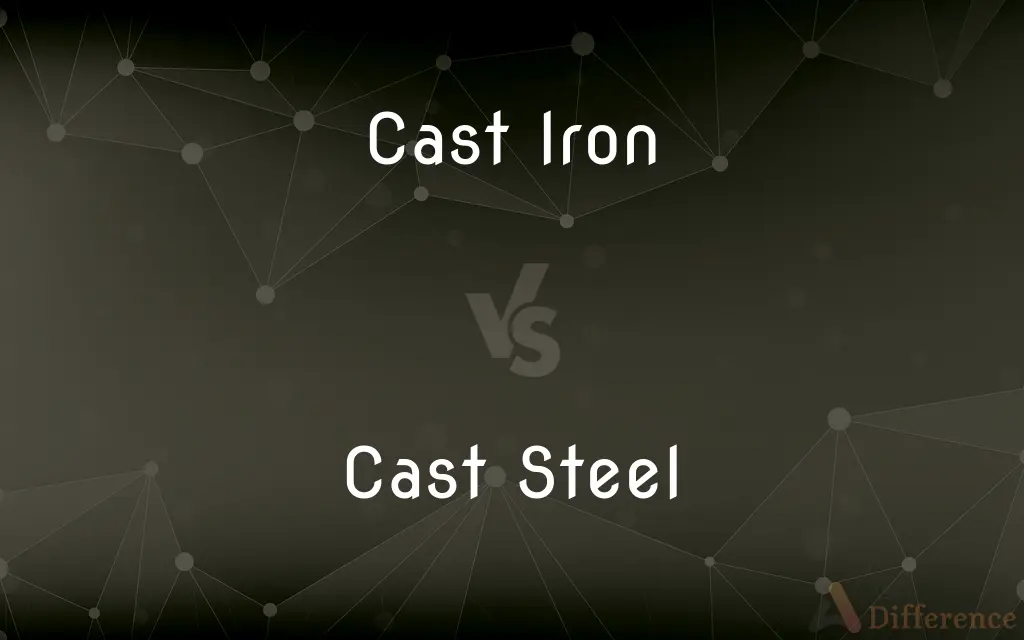Cast Iron vs. Cast Steel — What's the Difference?
Edited by Tayyaba Rehman — By Fiza Rafique — Published on December 21, 2023
Cast Iron vs. Cast Steel: Cast Iron is rich in carbon (>2%) and brittle, while Cast Steel has less carbon and is malleable.

Difference Between Cast Iron and Cast Steel
Table of Contents
ADVERTISEMENT
Key Differences
Cast Iron and Cast Steel are both ferrous metals that are melted and poured into molds to produce various products. While both share some similarities, their differences set them apart in terms of applications and properties.
Cast Iron typically contains more than 2% carbon, making it more brittle. On the other hand, Cast Steel generally contains between 0.05% and 2% carbon, which offers it greater malleability and toughness.
In terms of cost, Cast Iron is usually more economical due to its abundant raw materials and simpler production process. Cast Steel, because of its more intricate alloying elements and processes, can be more expensive.
From a functional perspective, Cast Iron's brittleness makes it more suitable for components that don't require a lot of flex, such as engine blocks and cast iron skillets. Cast Steel, with its superior ductility, finds its place in applications demanding shock resistance, like structural parts and gears.
Both Cast Iron and Cast Steel can be subjected to various heat treatments to improve their properties. However, due to the intrinsic differences in carbon content, their responsiveness to these treatments varies.
ADVERTISEMENT
Comparison Chart
Carbon Content
Typically >2%
Typically between 0.05% and 2%
Ductility
Brittle
Malleable and tougher
Cost
Generally more economical
Can be more expensive due to alloying elements and processes
Common Applications
Engine blocks, cookware
Structural parts, gears
Response to Heat Treatment
Less responsive due to high carbon content
More responsive owing to lower carbon content
Compare with Definitions
Cast Iron
Known for its brittleness due to high carbon content.
Because it's made of Cast Iron, the bench vise can crack if dropped.
Cast Steel
Known for its malleability and toughness.
The gears in the machine, being made of Cast Steel, can withstand heavy loads.
Cast Iron
Resistant to deformation but can break under tension.
The Cast Iron railing, though strong, can shatter if enough force is applied.
Cast Steel
Often used in structural applications requiring durability.
Cast Steel components are essential in heavy machinery for longevity.
Cast Iron
A ferrous metal with over 2% carbon content.
The classic skillet in the kitchen is often made of Cast Iron.
Cast Steel
A ferrous alloy with carbon content between 0.05% and 2%.
The bridge's girders are made of Cast Steel for enhanced strength.
Cast Iron
Commonly used in cookware for its heat retention properties.
Chefs prefer Cast Iron pans for searing meat effectively.
Cast Steel
Can be alloyed with other elements for enhanced properties.
The Cast Steel blade contains trace amounts of chromium for rust resistance.
Cast Iron
Typically gray or white, depending on its carbon form.
The gray appearance of the engine block indicates it's made of Cast Iron.
Cast Steel
Highly responsive to heat treatments to improve its properties.
The Cast Steel parts were heat-treated to achieve desired hardness levels.
Cast Iron
Made of cast iron.
Cast Iron
Rigid; inflexible
A cast-iron rule.
Cast Iron
Exceptionally strong or resistant
A cast-iron stomach.
Cast Iron
Alternative spelling of cast iron
Cast Iron
Alternative spelling of cast iron
Cast Iron
Made of cast iron. Hence, Fig.: like cast iron; hardy; unyielding.
Cast Iron
Extremely robust;
An iron constitution
Common Curiosities
What are common uses of Cast Steel?
Common uses include structural components, gears, and machinery parts.
Can both Cast Iron and Cast Steel be heat-treated?
Yes, both can be heat-treated, but their responsiveness varies due to their carbon content.
What are Cast Iron and Cast Steel primarily made of?
Both Cast Iron and Cast Steel are made of iron, but Cast Iron has over 2% carbon, while Cast Steel has 0.05% to 2% carbon.
Which one is more brittle: Cast Iron or Cast Steel?
Cast Iron is more brittle than Cast Steel.
Is Cast Steel more malleable than Cast Iron?
Yes, Cast Steel is more malleable and tougher than Cast Iron.
Can Cast Iron rust?
Yes, Cast Iron can rust if exposed to moisture without proper seasoning or coating.
Which is heavier, Cast Iron or Cast Steel?
Their weight primarily depends on the specific composition and the size of the object, not solely on being Cast Iron or Cast Steel.
Which is generally more expensive, Cast Iron or Cast Steel?
Cast Steel is often more expensive due to its alloying elements and processing.
Which has better shock resistance, Cast Iron or Cast Steel?
Cast Steel has better shock resistance due to its ductility.
What are common uses of Cast Iron?
Common uses include engine blocks, cookware, and certain types of piping.
Are there different types of Cast Iron and Cast Steel?
Yes, both Cast Iron and Cast Steel have subtypes based on their composition and properties.
Why is Cast Iron preferred for cookware?
Cast Iron retains heat well and provides even heating, making it ideal for cooking.
Can Cast Steel rust?
Yes, Cast Steel can rust, but alloying it with elements like chromium can enhance its rust resistance.
Is Cast Iron always gray in color?
No, Cast Iron can be gray or white, depending on its carbon form and other factors.
Why might Cast Steel be chosen over Cast Iron in certain applications?
Cast Steel might be chosen for its malleability, toughness, and its ability to withstand stresses and shocks better than Cast Iron.
Share Your Discovery

Previous Comparison
Rechargeable Batteries vs. Non Rechargeable Batteries
Next Comparison
Taproot vs. Fibrous RootAuthor Spotlight
Written by
Fiza RafiqueFiza Rafique is a skilled content writer at AskDifference.com, where she meticulously refines and enhances written pieces. Drawing from her vast editorial expertise, Fiza ensures clarity, accuracy, and precision in every article. Passionate about language, she continually seeks to elevate the quality of content for readers worldwide.
Edited by
Tayyaba RehmanTayyaba Rehman is a distinguished writer, currently serving as a primary contributor to askdifference.com. As a researcher in semantics and etymology, Tayyaba's passion for the complexity of languages and their distinctions has found a perfect home on the platform. Tayyaba delves into the intricacies of language, distinguishing between commonly confused words and phrases, thereby providing clarity for readers worldwide.












































